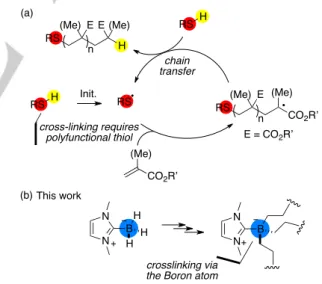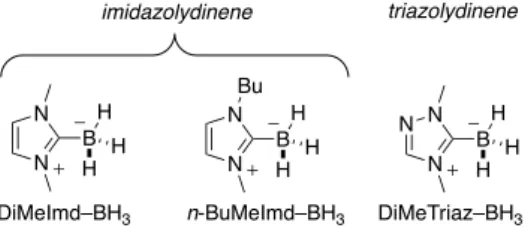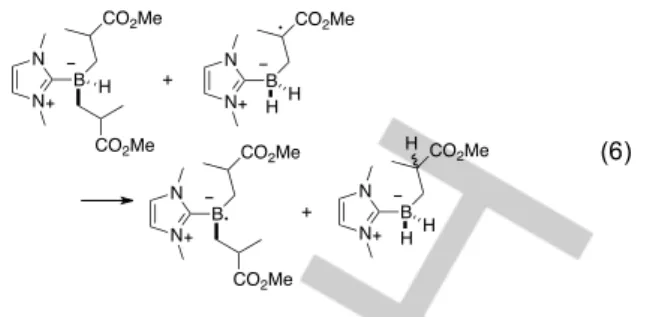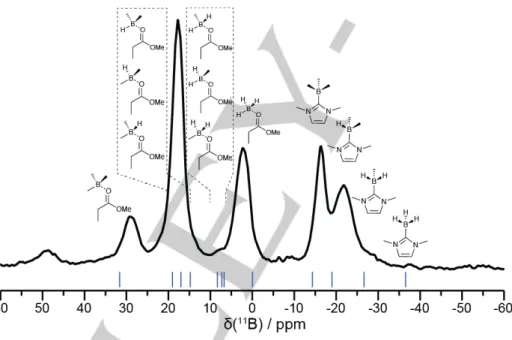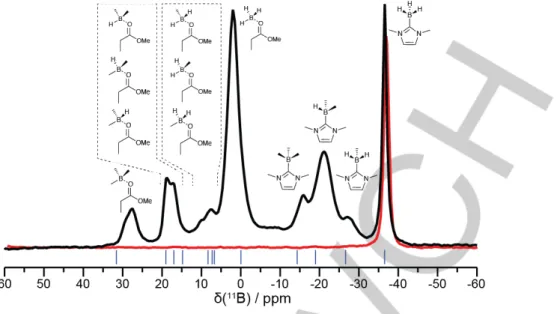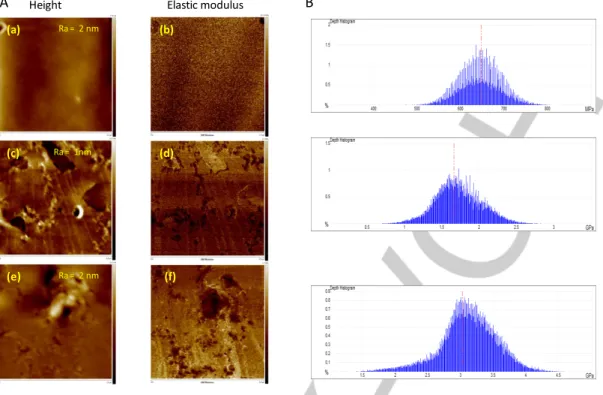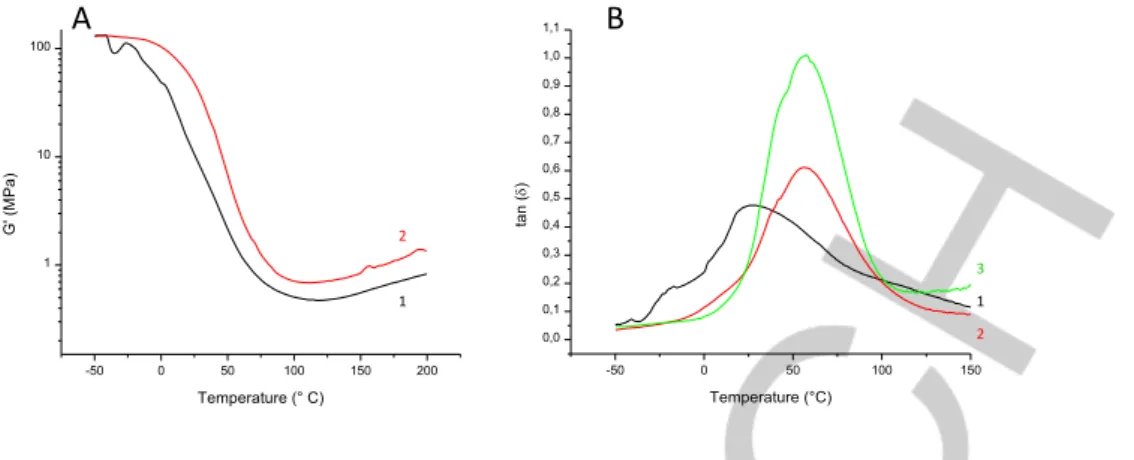HAL Id: hal-03220183
https://hal-univ-lyon1.archives-ouvertes.fr/hal-03220183
Submitted on 7 May 2021
HAL is a multi-disciplinary open access
archive for the deposit and dissemination of
sci-entific research documents, whether they are
pub-lished or not. The documents may come from
teaching and research institutions in France or
abroad, or from public or private research centers.
L’archive ouverte pluridisciplinaire HAL, est
destinée au dépôt et à la diffusion de documents
scientifiques de niveau recherche, publiés ou non,
émanant des établissements d’enseignement et de
recherche français ou étrangers, des laboratoires
publics ou privés.
reaction
Berengere Aubry, Rémi Canterel, Muriel Lansalot, Elodie Bourgeat-Lami,
Aissam Airoudj, Bernadette Graff, Celine Dietlin, Fabrice Morlet-Savary, Jan
Blahut, Ladislav Benda, et al.
To cite this version:
Berengere Aubry, Rémi Canterel, Muriel Lansalot, Elodie Bourgeat-Lami, Aissam Airoudj, et al..
Development of a borane-(meth)acrylate photo-click reaction. Angewandte Chemie International
Edi-tion, Wiley-VCH Verlag, 2021, �10.1002/anie.202103008�. �hal-03220183�
1
Development of a borane-(meth)acrylate photo-click reaction
Bérengère Aubry,
[a,b]Rémi Canterel,
[c,d]Muriel Lansalot,
[d]Elodie Bourgeat-Lami,
[d]Aissam Airoudj,
[a,b]Bernadette Graff,
[a,b]Céline Dietlin,
[a,b]Fabrice Morlet-Savary,
[a,b]Jan Blahut,
[e]Ladislav Benda,
[e]Guido
Pintacuda,*
[e]Emmanuel Lacôte,*
[c]Jacques Lalevée*
[a,b]Dedication ((optional))
[a] B. Aubry, A. Airoudj, B. Graff, Dr. C. Dietlin, Dr. F. Morlet-Savary, Prof. J.-P. Fouassier, Prof. J. Lalevée Université de Haute-Alsace, CNRS, IS2M UMR 7361, F-68100 Mulhouse, France
E-mail: jacques.lalevee@uha.fr [b] Université de Strasbourg, France [c] R. Canterel, Dr. E. Lacôte
Univ Lyon, Université Claude Bernard Lyon 1, CNRS, CNES, ArianeGroup, LHCEP, Bât. Raulin, 2 rue Victor Grignard, F-69622 Villeurbanne, France E-mail: emmanuel.lacote@univ-lyon1.fr
[d] R. Canterel, Dr. M. Lansalot, Dr. E. Bourgeat-Lami
Univ Lyon, Université Claude Bernard Lyon 1, CPE Lyon, CNRS, C2P2, 43 Bd du 11 novembre 1918, F-69616 Villeurbanne, France [e] Dr. J. Blahut, Dr. L. Benda, Dr. G. Pintacuda
Univ Lyon, Université Claude Bernard Lyon 1, École Normale Supérieure de Lyon, CNRS, CRMN, 5 rue de la Doua 69100 Villeurbanne, France Supporting information for this article is given via a link at the end of the document.((Please delete this text if not appropriate))
Abstract: The development of 3D printing fuels the need for new
photoinitiating systems working under mild conditions and/or leading to polymers with new and/or enhanced properties. In this context, we introduce herein N-Heterocyclic Carbene-borane complexes as reagents for a new type of photo-click reaction, the borane-(meth)acrylate click reaction. Remarkably, the higher bond number of boranes relative to thiols induced an increase of the network density associated with faster polymerization kinetics. Solid-state NMR evidenced the strong participation of the boron centers on the network properties, while DMA and AFM showed that the materials exhibit improved mechanical properties, as well as reduced solvent swelling.
Click reactions are reactions that can assemble fragments quickly, quantitatively and chemoselectively, without generating any by-product.[1] They are most useful when they run in the absence of solvents as well as in the presence of water and/or oxygen. Click reactions have been widely used in biology, where bio-orthogonal click reactions are a way to for example tag organelles in vivo.[2,3] They have also found important applications in polymer science.[4] In particular, thiol-ene[5–7] and thiol-yne[8] reactions have been employed in photopolymerizations. They proceed by a step-growth mechanism involving the radical propagation by addition of photogenerated thiyl radicals – using a type I or type II photoinitiator – onto a vinyl monomer, followed by a chain-transfer reaction (Figure 1). Thiol-ene reactions have for example recently been used for the synthesis of hydrogels,[9–12] bioorganic-functionalized materials,[13,14] polymer-dispersed liquid-crystalline phases,[15,16] 3D-printing,[17–19] telechelic polyethylenes,[20] etc. However, if thiol-ene and -yne reactions have been adopted by many academics, thiols often smell bad, and are generally too unstable for industrial applications, in particular in (meth)acrylate formulations because of the competitive Michael addition. More generally, more click-reactions usable in polymer science would certainly be of benefit.
We considered the radical thiol-(meth)acrylate process.[16,21–29] In contrast to thiol-ene reactions, where network formation derives
from single hydrothiolation steps from polyfunctional thiols, the high propagation rate constants of (meth)acrylates lead to network formation via tandem (meth)acrylate homopolymerizations-hydrothiolations (still only if the thiols are polyfunctional).
Figure 1. (a) Principle of the thiol-acrylate reaction; (b) Advantage of the
NHC-Boranes.
In our previous studies we showed that N-Heterocyclic Carbene-Borane complexes (NHC-Carbene-Boranes) of both the imidazolydinene (Imd) and triazolydinene (Triaz) carbene families (see structures in Figure 2) are excellent co-initiators for photopolymerizations in bulk or solvent and can be used interchangeably.[30–34] They reduce oxygen inhibition[31,35] and – in the case of the water-soluble DiMeTriaz–BH3 – allow polymerization in water.[32,34,36] Moreover, NHC-Borane-based type II co-initiators for radical photopolymerization have a labile B–H bond, and the resulting
RS H Init. CO2R’ RS RSH chain transfer N N B H H H (a) (b) N N B RS (Me) (Me) E (Me) CO2R’ E = CO2R’ n RS (Me) E H n (Me) E cross-linking requires polyfunctional thiol crosslinking via the Boron atom
2
radicals have high rate constant for addition onto double bonds. Therefore, photopolymerizations of (meth)acrylate resins with a NHC-Borane-based photoinitiating system (PIS) are fast, quantitative (high final C=C conversion), solventless and they can be performed under air or in water. That is, they meet many features of click-reactions. That is why we thought that NHC-Boranes not only could replace smelly thiols but, because they offer the possibility of linking more than one chain to the Boron atom, could lead to cross-linking via the heteroatom (as opposed to thiols which have only one site open for that, and necessitate multifunctional molecules for polyadditions). This would give birth to a new kind of click reaction, the borane-(meth)acrylate reaction, which we report herein.
Figure 2. Structures of the NHC–Boranes used in this work
The ideal thiol-ene reaction has a characteristic polymerization kinetic profile, as one thiol function is consumed for each reactive vinyl function, in the absence of any homopolymerization of the monomer. The consumption of the ene and thiol functions is simultaneous. In the thiol-(meth)acrylate version, the olefin is able to undergo radical polymerization (Figure 1a). Because of the fast polymerization rate of the (meth)acrylates, several monomer units are inserted before the H-transfer step from the thiol. We thus first aimed to prove that the NHC-boranes were compatible with these two steps, namely i) consecutive radical additions of the NHC-Boryl radicals onto double bonds, i.e. that might involve more than one addition on the same Boron atom and ii) consecutive chain-transfer reactions with the NHC-Borane, i.e. where the NHC– Borane would contribute more than one H.
• Addition step. As stated, the NHC-Boryl radicals add rather quickly to unsaturated partners, a feature we used to initiate radical homopolymerizations of (meth)acrylates and styrene[30– 32,34,36] and others to achieve organic cyclizations.[37–41]
(1)
(2)
(3)
To show the possibility of polyadditions, we first calculated the enthalpy associated to the addition of the NHC–Boryl radical, as well as that of a model for a NHC–Boryl radical substituted by one and two polymer chain(s) to one molecule of methyl methacrylate (MMA, eq. 1-3).
The first addition was found highly exothermic (–12.5 kcal.mol–1, uB3LYP/6-31+G* level, eq. 1), not surprisingly as this step is at the center of the NHC-Boranes efficiency to initiate radical polymerization. The second was found slightly less – albeit still very – favorable (–11.0 kcal.mol–1, eq. 2). Finally, the third addition is also slightly exothermic (–0.41 kcal.mol–1, eq. 3) suggesting that it also can occur.
For the experimental proof, we selected a methacrylic resin composed of 33.3 wt.% of 1,4-butanediol-dimethacrylate (1,4-BDMA), 33.3 wt.% of hydroxypropyl methacrylate (HPMA), 33.3 wt.% of urethane-dimethacrylate oligomer (resin 1), that was mixed with Acridine Orange (AO), diphenyldisulfide, and dimethyltriazolylidene-borane (DiMeTriaz–BH3, 0.05/2/2 wt./wt./wt.%) and irradiated. No precaution was taken to prevent the presence of air. The solid NHC–borane has only a limited solubility in the resin. Therefore, the relative concentrations of the reagents used to start from a homogeneous medium imply that the methacrylate functions are in excess (B–H/C=C 0.03:1). We measured the disappearance of the B–H bond (2130-2450 cm-1) and methacrylate functions (6160 or 1630 cm–1, depending on the sample thickness) by real time FT-IR spectroscopy (Figure 3). Gratifyingly, the borane signals disappear with the same kinetics as the methacrylate function. The final conversions are similar, despite the stoichiometry imbalance. These observations suggest that the excess methacrylate monomers also undergo radical homopolymerization (see next item), and that the polymerization is initiated by the addition of the NHC-Boryl radicals generated by H-atom translocation to the initially formed thiyl radicals, and not by the latter (see also below). But more interestingly, since the B–H consumption reaches 70%, this means that more than one chain is attached to the Boron atom. This is consistent with a very high rate constant for the addition of the NHC-boryl radicals onto electron-poor double bonds, at least one-hundred times higher than for thiyl radicals.[35]
Figure 3. Photopolymerization profiles of resin 1 under air, 1.4 mm thick
samples, upon LED@405 nm irradiation (start at t=10 s, 115 mW/cm²). Straight line: conversion of the methacrylate function as function of time. Dotted line: conversion of the B–H function as a function of time. Photoinitiating system: AO/PhSSPh/DiMeTriaz–BH3 (0.05/2/2 wt./wt./wt.%). N N B H H H N N N B H H H N N B Bu H H H
DiMeImd–BH3 n-BuMeImd–BH3 DiMeTriaz–BH3
imidazolydinene triazolydinene N N BH2 + CO 2Me N N B H H CO2Me N N BH CO2Me + CO 2Me N N B CO2Me H CO2Me + CO2Me N N B CO2Me CO2Me N N B CO2Me CO2Me CO2Me 0 100 200 300 400 500 0 10 20 30 40 50 60 70 80 F T -IR co n ve rsio n ( % ) Timeirradiation(s)
3
• Chain-transfer step. The key feature of the thiol-ene reaction is that after addition, the adduct radical should abstract a hydrogen atom from the thiol (see Figure 1). Under stoichiometric conditions, this transfer severely limits (but does not completely block) the homopolymerization of polymerizable olefins in the thiol-(meth)acrylate process. In our case that role would be played by the NHC-Borane, which should therefore undergo several H-atom translocations to cross-link in a new way.
NHC-Boranes can be used as radical mediators – thus transferring at least one H atom –,[42,43] and several H atoms of the same NHC-Borane can be transferred to thiyl radicals.[44] But there was not clear evidence that thermodynamics or steric hindrance would not limit the second (and third) transfers to C-centered radicals. We therefore started by calculating the enthalpy of the transfer reactions, first for the H-abstraction from the initial NHC–borane by a model adduct radical (eq. 4) and then for the H-abstraction of a hypothetical NHC–Borane with one (eq. 5) or two (eq. 6) polymer chains model already present on the Boron atom by the previous model adduct radical.
(4)
(5)
(6)
Again, in all cases the reactions were calculated to be enthalpically favorable (–5.9 kcal.mol–1 for eq. 4, –7.3 kcal.mol–1 for eq. 5, and –3.7 kcal.mol–1 for eq. 6).
We had in fact already shown that DiMeImd-BH3 is a chain transfer agent for the photopolymerization of MMA.[45] We therefore focused on DiMeTriaz-BH3 and sought to ascertain whether the latter could act as a chain-transfer agent too. We chose lauryl acrylate as the monomer so as to cover both acrylates and methacrylates. Lauryl acrylate was therefore photopolymerized using a LED@405 nm with two different ratios of DiMeTriaz–BH3 in the PIS. The conversions of the acrylate C=C function was determined by FT-IR spectroscopy (see Figure S1). The molecular weights of the polymers formed were determined by SEC after three different irradiation times (see Figures 4 and S2). The data are gathered in Table 1.
The first observation is that the dispersity (Đ; Table 1) of the polymer is lower for higher NHC-borane contents (compare Entries 3-4, 5-6, 7-8) suggesting a better control of the polymer architecture. Also, the polymer molecular weight strongly decreased when the NHC–Borane concentration increased. 2 wt.% of DiMeTriaz–BH3 were already enough to severely limit the Mn (Entries 2, 5, 7 and Figure 4). At 10 wt.% of DiMeTriaz– BH3, only oligomers were obtained. This establishes that NHC-Boranes are very efficient chain transfer agents and further confirms what we already observed in regular Type II photopolymerization.[45] Although here this was achieved in the presence of air.
Table 1. Number average molecular weight (Mn) and dispersity (Đ) during lauryl acrylate polymerizations performed with different amounts of DiMeTriaz–BH3, after different LED@405 nm irradiation times
Entry Irradiation time (s) DiMeTriaz–BH3 (wt.%) B–H / C=C (molar) Conversion (%) Mn (g.mol–1) Đ
1 40 0 0:1 4 47 200 1.80 2 40 2 0.12:1 21 2 000 1.48 3 40 10 0.63:1 25 1 500 1.30 4 130 0 0:1 57 54 800 2.36 5 130 2 0.12:1 58 2 500 1.71 6 130 10 0.63:1 58 1 800 1.28 7 300 2 0.12:1 80 4 400 4.68 8 300 10 0.63:1 70 1 900 1.33 N N B HH CO2Me N N B H + N N B HH CO2Me + H H H N N B H H N N B H H CO2Me N N BH2 CO2Me + N N B HH CO2Me N N BH CO2Me + H N N B HH CO2Me N N B CO2Me + N N B HH CO2Me + H CO2Me H N N B CO2Me CO2Me
4
Figure 4. Mn as a function of NHC-Borane wt. ratio for the photopolymerization of lauryl acrylate initiated by AO/DiMeTriaz–BH3/PhSSPh (0.05/x/2 wt./wt./wt. %) under LED@405 nm, after 130 s of irradiation, at 60 % conversion.
• Solid-state NMR analysis. In order to prove that the Boron participates to the cross-linking of the materials, we performed a
MAS 11B-NMR analysis in solid state. The spectrum of the material obtained with 2 wt.% of the NHC-Borane DiMeImd–BH3 and trimethylolpropane triacrylate (TMPTA) as the monomer is displayed in Figure 5. TMPTA was chosen for practical reasons, because it was more amenable to being conditioned in a rotor. The spectrum exhibits two series of signals, in the –30 to –10 ppm region and in the 0 to 30 ppm. In the former, two main peaks are observed, that correspond to a NHC–Borane environment, substituted at Boron by respectively 2 alkyl (–21.9 ppm) and 3 alkyl chains (–16.4 ppm), with a small shoulder near –30 ppm, corresponding to a monosubstituted Boron environment, as supported by calculation using the Orca software.[46] Conversely, peaks in the positive region correspond to Boron atoms where the NHC has de-coordinated from the Boron, following the interaction of the Boron empty p orbital with the carbonyl group of esters present in the network. Notably, signals at 2.1, 8.0 ppm (shoulder), 17.6 ppm and 29.0 ppm can be assigned to Boron atoms of boranes substituted with respectively zero, one, two, or three polymer chains, and a weak pyramidalization induced by coordination to a carbonyl.
Figure 5. Solid-state 11B MAS NMR spectrum of a polymer obtained from (0.05/2/2 wt./wt./wt.%) PIS. The spectrum was acquired at 31.25 kHz MAS using a spin echo experiment (32 𝜇s echo delay and 25 kHz RF power). The blue lines indicate the position of calculated 11B chemical shifts of the model structures sketched above the spectrum.
The presence of di- and trisubstituted NHC–Boranes indicates that the Boron atoms participate in the cross-linking (see also below). Because the polymerization was carried out with 2% NHC–Borane, the spectrum indicates almost no remaining monosubstituted NHC–Borane, proving that the cross-linking via the Borons is very efficient.
With a view to increase the amount of NHC–Borane in the formulations, we examined a liquid NHC–Borane, n-BuMeImd– BH3. The latter could be engaged in a polymerization at stoichiometric ratio (compared to the olefin). The solid-state 11B MAS NMR spectrum of the resulting material is shown in Figure 6 (black trace) and compared with that of pure solid NHC-Borane (DiMeTriaz-BH3, red trace). Peaks are very similar to those of Figure 5, except for the two most upfield signals. Notably, (i) a
sharp and symmetric signal has appeared at –36.6 ppm which is readily attributed to residual n-BuMeImd–BH3 trapped in the material; (ii) the shoulder at –27.1 ppm, assigned to mono-substituted n-BuMeImd–BH2Pn, is more pronounced than its equivalent in Figure 5, a consequence of the increased amount of NHC–Borane in the polymerization formulation. With more NHC– borane, the ratio of mono-substitution at Boron increases as the cross-linking due to the monomer happens too fast for the chain transfers to Boron to fully develop. In addition, some of the co-initiator becomes trapped in the rapidly cross-linking material. Nonetheless, even in this case it is clear that Boron strongly participates in the cross-linking, as expected for a Borane-(meth)acrylate reaction. 54000 54200 54400 54600 54800 55000 Mn (g.mol –1) 0 2 4 6 8 10 % DiMeTriaz-BH3 (wt %) 1400 1600 1800 2000 2200 2400 2600 2800 3000
5
Figure 6. Solid-state 11B MAS NMR spectra of a polymer obtained from AO/n-BuMeImd–BH
3/PhSSPh (0.05/50.2/2 wt./wt./wt.%) PIS (black trace) and of pure DiMeTriaz-BH3 (red trace). The spectra were acquired at 31.25 kHz MAS using a spin echo experiment (32 𝜇s echo delay and 25 kHz RF power). The blue lines indicate the positions of calculated 11B chemical shifts of the model structures sketched above the spectra.
• Consequences for the materials properties.
a) Mechanical properties. One of the main advantages of the thiol-ene reaction is the possibility to create highly structured networks. The control of the polymerization (without homopolymerization) allows the formation of polymers with high cross-link densities and therefore materials with higher Young moduli. In the case of the Borane-(meth)acrylate reaction, because the Boron can also participate to the cross-linking, we expected the mechanical properties – especially the rigidity – to improve, relative to a resin cured with a standard PIS.
Three cured polymers from resin 1, containing growing B–H/C=C molar ratios (0:1, 0.03:1, 0.15:1 – the latter borane content corresponds to the limit of solubility of DiMeTriaz–BH3 in the methacrylate resin) were synthesized and their Young modulus
determined by AFM (Figure 7). The Derjaguin-Müller-Toparov (DMT) fit model was used to calculate the elastic moduli (E) of the samples, following a previously published experimental procedure.[35] The samples surfaces are homogeneous (rugosity around 1 or 2 nm) on a 2 µm * 2 µm area according to the height maps (Figure 7A). The Young modulus average was determined using the maps and histograms presented in Figure 7B. The results show that higher concentrations of NHC-Borane resulted in increased Young moduli of the final polymers (Table 2), also associated with an increase of the Ta from 26.6°C without borane to 57.7°C for 10 wt.% of NHC-borane (see DMA results below). These data are clearly indicative of a higher cross-link density in the presence of NHC–Borane, itself a consequence of the borane-acrylate reaction.
6
Figure 7. A) Representative maps of topography (2 µm x 2 µm) and DMT modulus (2 µm x 2 µm) obtained with Peak Force QNM of cured resin 1 upon LED @405
nm under air. The PISs are: AO/PhSSPh (0.05/2 wt./wt.%, (a) and (b)), AO/PhSSPh/DiMeTriaz–BH3 (0.05/2/2 wt./wt./wt.%, (c) and (d)), AO/PhSSPh/ DiMeTriaz– BH3 (0.05/2/10 wt./wt./wt.%, (e) and (f)). The “Height” color scale (left column) represents the height from 0 to 17.9 nm, from 0 to 10.3 nm, from 0 to 24.3 nm for a, c and e respectively. The DMT modulus color scale (right column) represents the modulus from 0 to 331.9 MPa, from 0 to 2.2 GPa, from 0 to 3.3 Gpa for b, d and f respectively; B) Histograms of the Young’s modulus measurements for each sample
Table 2. Mean values of the Young’s modulus (determined by AFM), Ta and tan d (determined by DMA) for cured resin 1 with different PIS upon LED @ 405 nm, under air, 1.4 mm thickness (measured at T = 20°C)
PIS AO/PhSSPh (0.05/2 wt./wt.%) AO/PhSSPh/ DiMeTriaz–BH3 (0.05/2/2 wt./wt./wt.%) AO/PhSSPh/ DiMeTriaz–BH3 (0.05/2/10 wt./wt./wt.%) Young Mod. (GPa) 0.7 ± 0.1 1.7 ± 0.2 3.0 ± 0.1 Ta (°C) 26.6 55.9 57.7 tan δ 0.48 0.61 1.01
The storage moduli G’ of the polymerized resin 1 with the different PISs were determined by DMA (typical curves are presented in Figure S3). The materials obtained from the boron-containing PISs exhibit higher G’ and tan d than when resin 1 was cured without NHC-borane, and the more boron, the higher these values (Table 2 and Figure 9). According to the theory of rubber elasticity,[8,47] the storage modulus is proportional to the cross-link density. Thus, DiMeTriaz–BH3 clearly augments the latter and therefore the polymer rigidity.
The improvement of the polymer mechanical properties was also highlighted by the polymer segmental a-relaxation temperatures
(Ta) – corresponding to the maximum value of tan d, which is the ratio of the loss to the storage modulus of the polymer – (Table 2).[48] The polymer with the highest amount of NHC-Borane has the highest Ta. Indeed, the Ta doubled with only 2 wt. % NHC-Borane included in the formulation, which shows how efficient the NHC-Borane is to create a more structured network. The tan d peak as a function of temperature is also sharper in the presence of NHC-Borane (compare curves 2 and 3, Figure 8B). And the tan d values is higher with a higher amount of NHC-Borane. Above 150°C, the plateau ends and both G’ and G’’ slightly increase again, suggesting new reticulation nodes gradually appear.
The sharpening of the peak width indicative of a better structured network is one of the main features of the thiol-ene reaction.[49] That it is operant here also further validates the Borane-(meth)acrylate reaction as a new kind of polymer click-chemistry. The NHC-Borane likely lowers the amount of dangling chain ends and reduces the occurrence of the radical polymerization of resin 1 monomers. The enhanced tan d indicates that the cured polymer is more dissipative than the one synthesized without NHC-Borane. Thus, thanks to NHC-Borane it is possible to control the mechanical (rigidity, Ta) properties of the final materials.
Ra = 2 nm
Ra = 1nm
Ra = 2 nm
Height Elastic modulus
B
A
(a) (b)
(c) (d)
7
Figure 8. Storage modulus (A) and tan d (B) as a function of temperature for resin 1 polymerization upon LED@405 nm under air with the following PISs: AO/PhSSPh (0.05/2 wt./wt.%, curves A1 & B1), AO/PhSSPh/DiMeTriaz–BH3 (0.05/2/2 wt./wt./wt.%, curv. A2 & B2), and AO/PhSSPh/DiMeTriaz–BH3 (0.05/2/10 wt./wt./wt.%, curve B3)
b) Solvent resistance. To examine the influence of the NHC-Borane on the solvent resistance of the polymers, we submitted the materials obtained by photopolymerization of a Bisphenol A glycerolate dimethacrylate / Triethylene glycol dimethacrylate (BisGMA/TEGDMA, 70%/30%) resin (resin 2) under LED@405 nm to acetonitrile.[35] Resin 2 leads to networks already quite resistant to solvents, so it provided a good benchmark for evaluating the influence of the NHC-Borane. Thus, the materials obtained by polymerization of resin 2 with AO/PhSSPh (0.05/2 wt./wt.%) and with AO/PhSSPh/DiMe-Triaz-BH3 (0.05/2/2 wt./wt./wt.%) were immersed in acetonitrile for 17 h, without previous cleaning of the surface. In both cases, the polymer did not swell significantly (< 7%) and it remained tough. In contrast, after 17 h the solvent which contained the polymer obtained without NHC-Borane appeared more yellowish. This suggests that the material has a lower cross-link density, and therefore allows more traces of AO and other unbound (small) material trapped in the network to migrate to the solvent phase. In contrast, the resin cured with the three-component PIS releases less unbound compounds.
After immersion into the solvent, the samples were placed into an oven and heated at 50 °C for several hours to evaporate any trace of solvent. With this experiment it is possible to determine if the polymer has been damaged by the solvent. The more the polymer is sensitive to the solvent (because of a lack of cross-linking for example), the more it will release extractible organics, and therefore lose weight. Here, the weight loss of the oven-heated polymer is clearly lower in the Boron-containing material (Figure 8). Thus, the NHC-Borane strongly improves the resistance of the final material to acetonitrile. This is consistent with the higher cross-link density attained in the presence of NHC-Borane, as is the observation that the polymer upper surface was a bit tacky and less smooth in the material obtained without NHC-Borane.
Figure 9. Weight loss percentage vs. heating time (oven at 50 °C) for resin 2
after two types of curing. For curve 1 the PIS did not contain DiMeTriaz-BH3, whereas for curve 2 it contained 2 wt.% of DiMeTriaz-BH3. Irradiation was achieved by LEDs @ 405 nm, under air. The polymer was immersed in acetonitrile for 17 h prior to heating.
Conclusion. In the present work we introduced a new type of polymer click reaction, the Borane-(meth)acrylate process. Besides being an excellent class of co-initiators for free radical photopolymerization of (meth)acrylates, NHC-Boranes can be chain-transfer agents that allow the creation of polymers with a highly structured network where the Boron atoms participate to the cross-linking. With this new click reaction, it is possible to create polymers with particular properties simply by adjusting the ratio between the “Borane” and “ene” functions. For example, materials with a higher Ta and generally improved mechanical properties were synthesized using the NHC-Boranes. Further work will aim at developing materials with higher cross-linking densities. These might be obtained with multifunctional NHC-boranes. The resulting expected high-performance mechanical properties would be of great interest for several applications such as 3D printing and composite syntheses.
-50 0 50 100 150 200 1 10 100 G' (M Pa ) Temperature (° C) 1 2 -50 0 50 100 150 0,0 0,1 0,2 0,3 0,4 0,5 0,6 0,7 0,8 0,9 1,0 1,1 ta n ( d) Temperature (°C) 1 3 2
A
B
0 50 100 150 200 250 300 350 400 450 4 6 8 10 12 14 16 18 20 22 W e ig h t l o ss ( % )Time in oven at 50 °C (min)
1
8
Acknowledgements
We thank Université Claude Bernard Lyon 1, CNRS, CPE Lyon, UHA and ANR (grant ANR-16-CE07-0032 “Photo-B”) for funding of this work. BA and RC acknowledge ANR for a graduate fellowship. Access to high-field NMR was co-funded by the CNRS (IR-RMN FR3050).
Keywords: Boranes • Polymerization • Photochemistry • Click chemistry • Radical reactions
[1] H. C. Kolb, M. G. Finn, K. B. Sharpless, Angew. Chem. Int. Ed. 2001,
40, 2004–2021.
[2] J. C. Jewett, C. R. Bertozzi, Chem. Soc. Rev. 2010, 39, 1272–1279. [3] P. Thirumurugan, D. Matosiuk, K. Jozwiak, Chem. Rev. 2013, 113, 4905–4979.
[4] W. Xi, T. F. Scott, C. J. Kloxin, C. N. Bowman, Adv. Funct. Mater. 2014,
24, 2572–2590.
[5] A. B. Lowe, Polym. Chem. 2014, 5, 4820–4870.
[6] C. E. Hoyle, C. N. Bowman, Angew. Chem. Int. Ed. 2010, 49, 1540– 1573.
[7] A. B. Lowe, Polym. Chem. 2010, 1, 17–36.
[8] A. B. Lowe, C. E. Hoyle, C. N. Bowman, J. Mater. Chem. 2010, 20, 4745–4750.
[9] J. Wang, J. Niu, T. Sawada, Z. Shao, T. Serizawa, Biomacromolecules
2017, 18, 4196–4205.
[10] B. Chollet, L. DEramo, E. Martwong, M. Li, J. Macron, T. Q. Mai, P. Tabeling, Y. Tran, ACS Appl. Mater. Interfaces 2016, 8, 24870–24879. [11] S. A. Stewart, M. B. Coulson, C. Zhou, N. A. D. Burke, H. D. H. Stover,
Soft Matter 2018, 14, 8317–8324.
[12] S. L. Vega, M. Y. Kwon, K. H. Song, C. Wang, R. L. Mauck, L. Han, J. A. Burdick, Nat. Commun. 2018, 9, 1–10.
[13] J. C. Grim, T. E. Brown, B. A. Aguado, D. A. Chapnick, A. L. Viert, X. Liu, K. S. Anseth, ACS Cent. Sci. 2018, 4, 909–916.
[14] M. Denis, C. Softley, S. Giuntini, M. Gentili, E. Ravera, G. Parigi, M. Fragai, G. Popowicz, M. Sattler, C. Luchinat, L. Cerofolini, C. Nativi,
ChemPhysChem 2020, 21, 863–869.
[15] M. O. Saed, R. H. Volpe, N. A. Traugutt, R. Visvanathan, N. A. Clark, C. M. Yakacki, Soft Matter 2017, 13, 7537–7547.
[16] Y. Xia, X. Zhang, S. Yang, Angew. Chem. Int. Ed. 2018, 57, 5665– 5668.
[17] P. J. Scott, V. Meenakshisundaram, N. A. Chartrain, J. M. Sirrine, C. B. Williams, T. E. Long, ACS Appl. Polym. Mater. 2019, 1, 684–690.
[18] M. O. Saed, C. P. Ambulo, H. Kim, R. De, V. Raval, K. Searles, D. A. Siddiqui, J. M. O. Cue, M. C. Stefan, M. R. Shankar, T. H. Ware, Adv. Funct.
Mater. 2019, 29, n/a.
[19] A. C. Weems, K. R. Delle Chiaie, J. C. Worch, C. J. Stubbs, A. P. Dove,
Polym. Chem. 2019, 10, 5959–5966.
[20] S. Norsic, C. Thomas, F. D’Agosto, C. Boisson, Angew. Chem. Int. Ed.
2015, 54, 4631–4635.
[21] Y. Zhong, G. T. M. Nguyen, C. Plesse, F. Vidal, E. W. H. Jager, ACS
Appl. Mater. Interfaces 2018, 10, 21601–21611.
[22] C. L. Lewis, Y. Meng, M. Anthamatten, Macromolecules 2015, 48, 4918–4926.
[23] W. Hu, M. Chen, Q. Wang, L. Zhang, X. Yuan, F. Chen, H. Yang,
Angew. Chem. Int. Ed. 2019, 58, 6698–6702.
[24] K. Jin, N. Wilmot, W. H. Heath, J. M. Torkelson, Macromolecules 2016,
49, 4115–4123.
[25] A. F. Senyurt, H. Wei, C. E. Hoyle, S. G. Piland, T. E. Gould,
Macromolecules 2007, 40, 4901–4909.
[26] K. Owusu-Adom, J. Schall, C. A. Guymon, Macromolecules 2009, 42, 3275–3284.
[27] A. K. O’Brien, N. B. Cramer, C. N. Bowman, J. Polym. Sci., Part A:
Polym. Chem. 2006, 44, 2007–2014.
[28] N. B. Cramer, C. N. Bowman, J. Polym. Sci., Part A: Polym. Chem.
2001, 39, 3311–3319.
[29] H. Zhu, X. Yang, G. M. Genin, T. J. Lu, F. Xu, M. Lin, J. Mech. Behav.
Biomed. Mater. 2018, 88, 160–169.
[30] M.-A. Tehfe, M. Makhlouf Brahmi, J.-P. Fouassier, D. P. Curran, M. Malacria, L. Fensterbank, E. Lacôte, J. Lalevée, Macromolecules 2010, 43, 2261–2267.
[31] M.-A. Tehfe, J. Monot, M. M. Brahmi, H. Bonin-Dubarle, D. P. Curran, M. Malacria, L. Fensterbank, E. Lacôte, J. Lalevée, J.-P. Fouassier, Polym.
Chem. 2011, 2, 625–631.
[32] M.-A. Tehfe, J. Monot, M. Malacria, L. Fensterbank, J.-P. Fouassier, D. P. Curran, E. Lacôte, J. Lalevée, ACS Macro Lett. 2012, 1, 92–95.
[33] J. Lalevée, S. Telitel, M. A. Tehfe, J. P. Fouassier, D. P. Curran, E. Lacôte, Angew. Chem. Int. Ed. 2012, 51, 5958–5961.
[34] S. Telitel, S. Schweizer, F. Morlet-Savary, B. Graff, T. Tschamber, N. Blanchard, J. P. Fouassier, M. Lelli, E. Lacôte, J. Lalevée, Macromolecules
2013, 46, 43–48.
[35] B. Aubry, D. Subervie, M. Lansalot, E. Bourgeat-Lami, B. Graff, F. Morlet-Savary, C. Dietlin, J.-P. Fouassier, E. Lacôte, J. Lalevée,
Macromolecules 2018, 51, 9730–9739.
[36] F. LeQuéméner, D. Subervie, F. Morlet-Savary, J. Lalevée, M. Lansalot, E. Bourgeat-Lami, E. Lacôte, Angew. Chem. Int. Ed. 2018, 57, 957– 961.
[37] Y.-J. Yu, F.-L. Zhang, J. Cheng, J.-H. Hei, W.-T. Deng, Y.-F. Wang,
Org. Lett. 2018, 20, 24–27.
[38] S.-C. Ren, F.-L. Zhang, A.-Q. Xu, Y. Yang, M. Zheng, X. Zhou, Y. Fu, Y.-F. Wang, Nat. Commun. 2019, 10, 1934.
[39] S.-C. Ren, F.-L. Zhang, J. Qi, Y.-S. Huang, A.-Q. Xu, H.-Y. Yan, Y.-F. Wang, J. Am. Chem. Soc. 2017, 139, 6050–6053.
[40] J. Qi, F.-L. Zhang, J.-K. Jin, Q. Zhao, B. Li, L.-X. Liu, Y.-F. Wang,
Angew. Chem. Int. Ed. 2020, 59, 12876–12884.
[41] J.-K. Jin, F.-L. Zhang, Q. Zhao, J.-A. Lu, Y.-F. Wang, Org. Lett. 2018,
20, 7558–7562.
[42] A. Solovyev, S.-H. Ueng, J. Monot, L. Fensterbank, M. Malacria, E. Lacôte, D. P. Curran, Org. Lett. 2010, 12, 2998–3001.
[43] S.-H. Ueng, L. Fensterbank, E. Lacote, M. Malacria, D. P. Curran, Org.
Biomol. Chem. 2011, 9, 3415–3420.
[44] X. Pan, A.-L. Vallet, S. Schweizer, K. Dahbi, B. Delpech, N. Blanchard, B. Graff, S. J. Geib, D. P. Curran, J. Lalevée, E. Lacôte, J. Am. Chem. Soc.
2013, 135, 10484–10491.
[45] D. Subervie, B. Graff, S. Nerkar, D. P. Curran, J. Lalevée, E. Lacôte,
Angew. Chem. Int. Ed. 2018, 57, 10251–10256.
[46] F. Neese, WIREs Comput. Mol. Sci. 2018, 8, e1327.
[47] P. J. Flory, Principles of Polymer Chemistry, Cornell University Press, Ithaca, NY, 2006.
[48] A. Hajighasem, K. Kabiri, J. Polym. Res. 2013, 20, 218. [49] Q. Li, H. Zhou, C. E. Hoyle, Polymer 2009, 50, 2237–2245.
9
Entry for the Table of Contents
Insert graphic for Table of Contents here. ((Please ensure your graphic is in one of following formats))
N-Heterocyclic Carbene-borane complexes can lead to a photochemically-triggered borane-acrylate click reaction, a new type of photo-click reaction. Because boranes have three substituents they can participate to cross-linking, unlike thiols in
thiol-(meth)acrylate reactions. This generates materials with improved mechanical properties. Institute and/or researcher Twitter usernames: ((optional))
NHC B H HH
